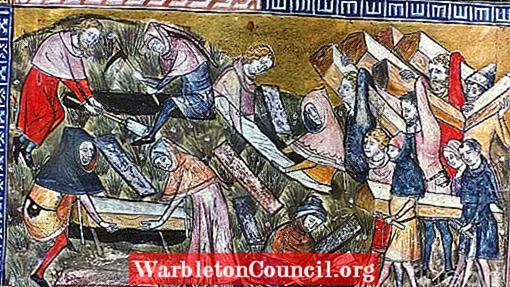
Content
- Anatomy of the ventral tegmental area
- Functions of this structure
- The brain reward system
- Associated disorders

The ventral tegmental area is a region of the midbrain, also known as the midbrain, which is very important because of its involvement in the reinforcement circuit, responsible for feelings of pleasure and motivated behavior. It is also involved in other diverse functions by sending projections to cortical and subcortical areas.
In this article we will describe the anatomical features, the main functions and disorders associated with the ventral tegmental area. We will emphasize mainly the role that this structure plays in the brain's reward system.
- Related article: "Parts of the human brain (and functions)"
Anatomy of the ventral tegmental area
The concept "ventral tegmental area" refers to a set of neurons that are located at the base of the midbrain, the intermediate region of the brain stem. In Latin the word "tegmentum" means "covering" or "covering"; therefore, the name highlights the fact that this area constitutes a layer of neurons that covers the midbrain.
Four main cell nuclei have been identified in the ventral tegmental area: the paranigral nucleus, the pigment parabrachial area, the retroflexed parafascicular area, and the rostromedial tegmental nucleus. The characteristic dopaminergic neurons of this region of the brain are located mainly in the first two.
Together with the substantia nigra and the retrorubral field, also located in the midbrain, the tegmental area contains most of the dopaminergic neurons of the brain. Dopamine is a neurotransmitter of the class of catecholamines that is involved in increasing heart rate and learning by operant conditioning, among other aspects.
- You may be interested: "Midbrain: characteristics, parts and functions"
Functions of this structure
Dopaminergic neurons of the ventral tegmental area are part of the mesocortical and mesolimbic systems. While the mesocortical system connects this region with the frontal lobes, the mesolimbic system sends projections to the nucleus accumbens, a fundamental structure of the brain's reward system, as does the ventral tegmental area.
The mesocortical pathway plays a fundamental role in cognition; in particular, it allows information about emotion and motivation to reach the frontal lobes. After receiving these inputs, the higher brain structures generate the responses that will be executed as a consequence.
However, the main functions of the ventral tegmental area are associated with its involvement in the brain's reward system, also known as the reinforcement circuit, which is initiated by the dopaminergic projections of neurons in this region. This pathway is closely related to the mesolimbic system.
The brain reward system
The ventral tegmental area is a key structure of the brain's reward system, the biological basis of pleasure and behavioral motivation, since appetitive stimuli activate this region. In this way, the reward circuit is involved in multiple behaviors, such as those related to food, sex or addictions.
When the body detects pleasant stimulation, the ventral tegmental area sends dopaminergic projections to the nucleus accumbens. Increasing the concentration of the neurotransmitter in this area has a reinforcing effect on the behavior associated with obtaining pleasure or satisfaction.
When these inputs reach the cerebral cortex, the information obtained through the reinforcement circuit can be integrated and managed by the higher cognitive functions. It is important highlight the reciprocity of ventral tegmental area connections, which allows continuous feedback between this structure and those to which it sends references.
Associated disorders
Scientific research has identified several disorders that present with alterations in the dopaminergic pathways of which the ventral tegmental area is a part. In general, these types of disorders involve both the mesolimbic and mesocortical pathways, which are closely linked.
The neuropsychological disorders most frequently attributed to structural and / or functional problems in dopamine transmission they are Parkinson's disease, attention deficit hyperactivity disorder, and schizophrenia.
In the latter case, positive symptoms, such as hallucinations and delusions, are associated with alterations in the mesolimbic pathway. Failures in the mesocortical system produce negative symptoms, consisting of cognitive, emotional, and motivational deficits.
On the other hand, the ventral tegmental area and the nucleus accumbens are the two regions of the nervous system in which the drugs and other potentially addictive substances they have a more significant effect.
Alcohol, nicotine, cocaine, amphetamine, and heroin, among others, have agonist effects on dopamine; This explains the physiological, motor and psychological consequences of the use of these substances, both in the short and long term, including addiction.
- Holstege, G .; Georgiadis, J. R .; Paans, A. M .; Meiners, L. C .; Van Der Graaf, F. H. & Reinders, A. A. (2003). Brain activation during human male ejaculation. The Journal of Neuroscience: The official journal of the Society for Neuroscience, 23 (27): 9185–93.
- Ranaldi, R. (2014). Dopamine and reward seeking: the role of ventral tegmental area. Reviews in the Neurosciences, 25 (5): 621-30.


